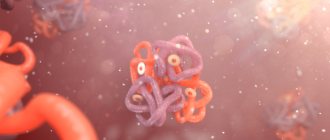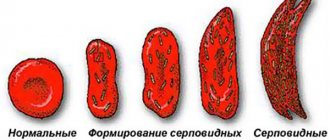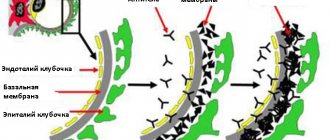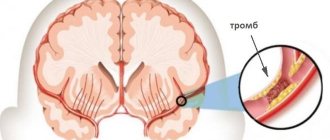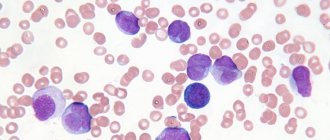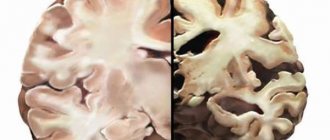Share article on social networks:
Hyperchromic anemia is a disease with a characteristic change in blood composition in terms of the ratio of the number of red blood cells and hemoglobin. It is a type of anemia, a typical symptom is a pathologically low number of red blood cells and a sharp increase in hemoglobin levels. The disease provokes the rapid destruction of red blood cells, with the loss of their color intensity and loss of natural functionality, which causes rapid cell death.
In typical anemic forms, there is a decrease in the number of both red blood cells and hemoglobin. But anemia is a rather multifaceted disease that has many types. Hyperchromic anemia, the causes of which lie in abnormal changes in the activity of the immune system, is one of the most dangerous types of this disease.
Doctors have long established reference values for the norm of red blood cells and hemoglobin, and any deviations from them are determined by analyzing the level of folic acid concentration in the serum. This helps to determine the degree of progress of hyperchromic anemia and clarify the prognosis for recovery. The obtained data is compared with the established standard values and the deviation coefficient is recorded.
Important: in case of hyperchromic and megaloblastic anemia, differentiation must be made with other diseases, including chronic infectious inflammation. Otherwise, anemia is not recognized as a primary disease, but as a by-product or consequence of an ongoing illness.
In fact, the hyperchromic type of anemia is a type of iron deficiency. Clinical picture of development: abnormally formed red blood cells enter the blood lymph, transforming into megablasts (hence the second name of the disease - megablastic anemia), but they contain a critically high amount of iron, which has a detrimental effect on the ability to transport oxygen to organs and tissues.
What is hyperchromic anemia
The disease, known to most people as anemia, in official medicine called “anemia”, is associated with a drop in hemoglobin levels. In the hyperchromic form, the number of healthy red blood cells simultaneously decreases and defective ones appear: containing excess iron. Thanks to this substance, the blood cells become saturated with hemoglobin, so their median clearing is covered with a scarlet color (this can be seen in laboratory tests). There are 2 types of hyperchromic anemia:
- Megaloblastic (macrocytic) - characterized by a violation of DNA and RNA synthesis, which leads to the appearance of very large red blood cells (megaloblasts and megalocytes) in the bone marrow. This anemia can be inherited.
- Non-megaloblastic - DNA synthesis is normal, the bone marrow does not produce megaloblasts, but defective red blood cells are present.
Most doctors do not consider anemia to be an independent disease, since it can develop against the background of a primary lesion of the blood system or with other pathologies that are in no way related to this. For this reason, there is no strict nosological classification and, in addition to the already mentioned division of the hyperchromic type into 2 types, there is a grouping according to the conditions to which it corresponds:
- Vitamin B12 deficiency (pernicious) anemia - Addison-Birmer disease, malignant anemia caused by a lack of vitamin B12. It is characterized by the formation of immature megaloblasts in the bone marrow and can manifest as neurological disorders.
- Folate deficiency anemia is also pernicious anemia, but occurs when there is a deficiency of folic acid.
- Myelodysplastic syndrome - characterized by cytopenia (deficiency of one or more types of blood cells) in the peripheral blood, dysplasia (improper development) of the bone marrow. The disease is prone to transition to the acute form of leukemia (poor-quality damage to the hematopoietic system), and is difficult to treat (maintenance therapy is carried out). According to official statistics, 80% of patients with myelodysplastic syndrome are over 60 years of age.
If myelodysplastic syndrome
Hyperchromic anemia can occur in combination with myelodysplastic syndrome. Pathology occurs against the background of radiation exposure, chemotherapy, potent treatment of tumor-like formations of the bone marrow, and leukemia. Thus, brain hematopoiesis is subject to severe toxic effects. In addition to the severe symptoms of the main disease, the patient additionally experiences:
- Severe shortness of breath even without physical activity.
- Excessive fatigue.
- Constant dizziness, tachycardia.
An accurate diagnosis is established by blood counts.
Causes
Deficiency of vitamin B12 (cyanocobalamin) and folic acid are the most common starting points for the development of hyperchromic anemia, but these conditions can occur under the influence of a number of factors. There is a specific list of reasons for each situation. Lack of cyanocobalamin is provoked by:
- pathological processes in the ileum, in which the digestibility of nutrients is impaired due to poor absorption by its walls;
- infectious intestinal pathologies, which also disrupt the absorption of vitamins;
- worms – tapeworms and bacteria actively absorb vitamin B12;
- atrophic gastritis, in which insufficient synthesis of intrinsic Castle factor (an enzyme that converts cyanocobalamin from an inactive form to an absorbable one) is observed in the parietal cells of the stomach.
In hyperchromic anemia, which occurs as a result of folic acid deficiency, the provoking factors look different. Women often encounter this condition during pregnancy, since all the folic acid is used to build the neural tube of the fetus. The influence may also be exerted by:
- alcoholism;
- liver diseases (especially hepatitis, cirrhosis, liver failure).
Separately, doctors mention hyperchromic macrocytic anemia, which is hereditary in nature (autosomal recessive transmission from parents) and develops against the background of genetic mutations, and in women, a prerequisite for its occurrence is the use of hormonal drugs. If we do not consider individual types of anemia, in which hyperchromic nuclei appear in red blood cells, common causes include:
- prolonged fasting or poor nutrition (with a deficiency of vitamins and microelements in food);
- smoking;
- presence of tumors;
- infections (especially HIV) and viruses;
- regular large loss of blood during menstruation;
- stomach cancer, gastrectomy (complete excision);
- hypothyroidism (thyroid hormone deficiency);
- taking medications (Metformin, Neomycin, Difenin);
- frequent intestinal disorders.
Causes of anemia – Dr. Komarovsky
What contributes to the development of the disease
As soon as a patient is diagnosed with hyperchromic anemia, he will ask what it is. After all, in principle, everyone has heard about anemia. But why is she hyperchromic and what provokes it? No disease just happens.
In this case, pathology occurs due to a number of reasons:
- lack of sufficient amounts of B vitamins;
- lack of folic acid;
- failure of the immune system;
- infectious ailments;
- abnormal absorption of minerals and vitamins necessary for the body;
- use of medications;
- the presence of tumors, both benign and malignant;
- excessive addiction to alcoholic beverages;
- poor nutrition;
- disrupted daily routine;
- constant presence in rooms where there is little fresh air;
- severe menstrual blood loss.
Hyperchromic anemia is characterized by a decrease in the amount of iron or its poor absorption.
If pathology is detected in a child, it may have been provoked by:
- prematurity;
- various disorders throughout the entire period of pregnancy;
- poor nutrition;
- complementary foods that were introduced incorrectly, or poor quality formulas;
- insufficient time spent outdoors;
- non-compliance with the prescribed regime.
Symptoms of hyperchromic anemia
The disease has external and internal manifestations: the latter imply changes in general well-being, which are not always specific and do not make it possible to make an accurate diagnosis. These symptoms of hyperchromic anemia include:
- increased drowsiness, fatigue;
- decreased performance;
- loss of concentration.
This clinical picture is characteristic of most cases of anemia, so the disease is recognized only after laboratory tests. If the course is more severe, the following may be added:
- tachycardia (rapid heart rate);
- shortness of breath with minimal physical exertion (even after brisk walking);
- tinnitus (not constant);
- sleep disorders;
- loss of appetite;
- headache;
- decreased libido (sexual desire).
In almost all cases of hyperchromic anemia, changes in appearance can be observed: the skin turns pale, the skin becomes thinner, becomes dry, and the hands may acquire a yellowish tint. Early graying appears in the hair. The general clinical picture of severe anemia is supplemented by the following symptoms:
- weight loss;
- visual and hearing impairment;
- nausea, vomiting;
- loss of taste, lack of craving for previously favorite foods and dishes;
- muscle weakness;
- numbness of the lower extremities;
- feeling of chilliness;
- redness of the tongue to a crimson color, the surface becomes shiny.
Persons who have hyperchromic anemia combined with myeloplastic syndrome often experience dizziness and increased fatigue. Chest pain with strong heartbeat and shortness of breath is possible. If the nervous system is severely damaged, the sensitivity of the fingers (toes and arms) is impaired, and loss of consciousness and convulsions may occur. Blood pressure is predominantly low, the liver is enlarged (palpable by palpation).
Symptoms and signs
The full cycle of hematopoiesis takes a lot of time. The human body is not able to instantly identify the problem. The disease begins to progress, provoking negative manifestations not only from the hematopoietic system, but also from the nervous system (peripheral and central) and the gastrointestinal tract.
Common symptoms of hyperchromic anemia include:
- pain in the sternum;
- hearing and vision impairment;
- fainting;
- feeling tired;
- cardiopalmus;
- weight loss;
- decreased appetite;
- whitish coating on the tongue;
- nausea and vomiting;
- deterioration of taste;
- signs of tachycardia.
Important information: How to treat iron deficiency anemia in young children (children) and symptoms of IDA
On the part of the central nervous system, negative symptoms manifest themselves later, but more intensely. At first, your arms and legs begin to go numb, and your muscles feel stiff. After some time, the gait changes, convulsions occur, and sensitivity in the limbs decreases.
In this case, the patient becomes nervous and irritable, and intoxication begins in his body due to an increase in the level of urea in the blood plasma.
Signs of the hyperchromic form of anemia resemble manifestations of other disorders in the body, including folate deficiency (with megaloblastic anemia), but they should be a reason for immediate consultation with a doctor.
Possible complications
In children, anemia, in which hyperchromia of red blood cells is observed, can lead to a lag in mental and physical development, a decrease in the body's defenses (the child will often catch ARVI, and it will be difficult to tolerate even a cold). In adults, a common complication of anemia is a lack of oxygen in the blood, damage to the nervous system, which causes:
- hypoxia (oxygen starvation) of the brain;
- deterioration of memory and thinking;
- death of brain cells and disruption of its blood vessels;
- heart failure (can be fatal).
Complications of anemia
Symptoms and causes of pathology
Treatment of any disease begins only after the patient is ready to visit the clinic and seeks help from a doctor. Of course, only symptoms that clearly indicate health problems can guide the patient to take such an important step. The more information a person has about the symptoms of various pathologies, the sooner he will learn to notice health problems in time and prepare himself to visit the clinic.
To maintain good health, every person must lead a healthy lifestyle, eat right, and also follow doctors’ recommendations on how to prevent the occurrence of pathologies, including anemia.
Causes of anemia
The causes of hyperchromic anemia are varied, but the most common is the intake of insufficient B vitamins into the human body.
Foods High in Vitamin B12
Most often, such vitamin deficiency is observed in women who independently prescribe a diet for themselves, accompanied by a categorical ban or significant limitation on the consumption of products that contain B vitamins. Unfortunately, in some cases a person eats correctly, but despite this, the body still continues experience a deep deficiency of such vitamins. This happens when the patient has other pathologies:
- intestinal lymphoma (a malignant tumor that affects the intestinal wall);
- sprue (white diarrhea is a pathology that affects those who visit subtropical and tropical countries);
- celiac disease (a disease in which the villi of the small intestine are completely damaged).
These diseases, as well as taking medications that are prescribed to prevent seizures, provoke disorders due to which the vitamins entering the body are not able to be absorbed.
For diseases such as psoriasis, exfoliative dermatitis, as well as during gestation, the body needs an increased amount of vitamin B12
If you do not change your lifestyle and diet, your body begins to lack this important vitamin.
Hyperchromic anemia can be triggered by atrophic gastritis, metabolic failure, and alcohol abuse. Also, this disease can act as a complication after surgery on the gastrointestinal tract.
Excessive drinking can lead to anemia
It is important to begin treatment of such a disease immediately, since inaction can cause serious complications that affect the functioning of the nervous system and provoke a weakening of the immune system. Ignoring signs and lack of drug therapy can cause mental retardation in children and critical age-related changes in adults
Also, hyperchromic anemia can favor frequent infections of the body and weak resistance of the immune system to such undesirable processes.
A phenomenon such as macrocytosis is also dangerous, followed by the development of macrocytic anemia, characterized by the rapid destruction of large red blood cells, and their formation and formation, on the contrary, slow down significantly. Depending on the size of red blood cells, doctors distinguish between normocytic, macrocytic, microcytic, and megaloblastic anemia.
Symptoms
Deficiency anemia manifests itself in the first stages in the form of malaise, the inability to perform usual manipulations, accompanied by minor physical activity.
If you do not see a doctor in time, other symptoms begin to appear:
- dizziness;
- noise in ears;
- loss of appetite;
- changes in taste perception;
- cardiopalmus;
- dyspnea;
- bright red color of the tongue;
- stitching pain;
- numbness of the limbs;
- occurrence of convulsions.
One of the symptoms of anemia may be tinnitus
With vitamin B12 deficiency, changes in external signs are observed. The skin of a sick person acquires a yellowish tint, the hair loses its natural color and begins to turn grey. Hair thins due to its fragility and rapid loss. There is also increased fragility of the nail plate.
You also have to experience unpleasant symptoms related to the gastrointestinal tract. In particular, quite often patients complain of constipation or diarrhea. Poor health is provoked by an increase in blood pressure.
Diagnostics
The absence of a specific clinical picture for anemia of any type increases the importance of diagnostic measures to clarify the disease. A general blood test is the primary test, the results of which can show changes in the structure of red blood cells (shape and size of cells) and detect nuclear Jolly bodies. If there is a suspicion of hyperchromic anemia, the doctor additionally prescribes:
- biochemical blood test - to determine the level of bilirubin, serum iron level;
- fluoroscopy of the abdominal cavity (abdominal organs);
- Ultrasound of the digestive organs;
- immunological study - helps to identify antibodies that are specific against the cytoplasmic antigens of gastric parietal cells and the internal factor of Castle.
ENDOCRINE DISEASES
Hypothyroidism
Up to 50% of patients may suffer from mild anemia: hypothyroidism (IHorton et al., 1976).
Etiology
It has been reported that total erythrocyte mass decreases in hypothyroidism (Muldowney et al., 1957), but these changes may be masked to some extent by a parallel decrease in plasma volume. Both bone marrow studies and iron kinetics studies indicate suppression of erythropoiesis, which is likely due to decreased tissue oxygen consumption and decreased metabolic activity. It is believed that as a result of the indirect effect of these factors on the secretion of erythropoietin, its level falls; Thyroxine does not appear to stimulate erythropoiesis. However, as already mentioned, it is difficult to insist on these claims since it is impossible to determine the level of erythropoietin in normal plasma and therefore confirm a drop in its level. In addition, there is evidence to suggest that thyroid hormone has a direct stimulating effect on the growth of erythropoietin-dependent erythroid colonies.
Treatment
For mild forms of hyperchromic anemia, the basis of the therapeutic regimen is dietary correction, especially if the problem lies in a deficiency of folic acid or vitamin B12. Additionally, it is important to take 8 mg of iron with food per day. The menu is based on the following products:
- chicken, beef liver (2-3 times a week);
- buckwheat grain;
- fish (especially cod);
- meat (it is advisable to include a rabbit in the diet);
- chicken eggs;
- cheeses;
- legumes.
Be sure to eat fresh vegetables and fruits to complement the list of foods useful for anemia. Spicy and fried foods should be avoided as they irritate the digestive system. Caffeine is also excluded, since it interferes with the absorption of iron. This diet should be followed for several months (in some cases, more than a year); it is relevant for all stages of the disease, but individual correction of the diet for a specific clinical picture is possible. Drug treatment depends on the causes of anemia and its course:
- Therapy for mild deficiency conditions begins with the administration of Cyanocobalamin: a synthetic analogue of vitamin B12, which is taken orally or injected intramuscularly. If 1-1.5 weeks after the start of its use no positive dynamics are observed, the doctor prescribes Folic acid (tablets), Femibion. In some cases, simultaneous treatment with both drugs is carried out.
- For moderate anemia, Cyanocobalamin or Oxycobalamin (a stronger drug for severe cases) is administered intravenously and on days 5-8 the level of reticulocytes is monitored: their number should increase by 20-30%.
- If necessary, iron supplements are prescribed - Maltofer, Hemofer (tablets, injections), especially if the disease is diagnosed in a child.
- During pregnancy (or after childbirth, if the condition does not improve), the doctor may prescribe intravenous vitamin supplements to the patient, starting with large doses. Afterwards they decrease, and the injection form is replaced by the oral one.
The restoration of blood counts occurs quickly: within a month you can see the result, but neurological disorders are eliminated more slowly and may require additional medications. If the initial (mild) form of hyperchromic anemia can be treated on an outpatient basis (at home), then the moderate and severe form requires the patient to be placed in a hospital, where he will be given injections of drugs and constantly monitor his condition. A few points for treating such cases of anemia:
- A sharp disturbance in hemodynamics, a drop in hemoglobin below 70 g/l (severe form of anemia) requires immediate hemotransfusion - blood transfusion.
- Myelodysplastic syndrome requires hospitalization, blood transfusion (transfusion of red blood cells and platelets, often with cell replacement) and intravenous administration of drugs that accelerate the division of blood cells to prevent leukemia.
- If treatment involves injecting medications simultaneously with taking pills, this course lasts 2-3 months. After that, 1 injection is given once a week, leaving the tablets, and after 2 months they are given once every 14 days. The main form of treatment for non-serious conditions is tablets.
Anemia How to treat anemia?
Types of macrocytic anemia
All macrocytoses are divided into 2 large groups:
- Megaloblastic - appear due to a deficiency of microelements and B vitamins. The main laboratory signs of this type of anemia are the presence of megalocytes, destroyed red blood cells in the intracerebral substance, and a decrease in platelet levels.
- Non-megaloblastic - caused by liver pathology. Most often accompany myelodysplastic syndrome.
Also, all macrocytic anemias are divided into forms depending on the level of reticulocytes (precursors of red blood cells) in the blood:
- normoregenerative - the number of reticulocytes is normal;
- hyporegenerative - the concentration of reticulocytes is reduced, and accordingly, there will be an insufficient number of red blood cells in the blood;
- hyperregenerative - increased content of reticulocytes in the blood.
Also, all macrocytic anemias are divided into primary (hereditary, idiopathic) and secondary (symptomatic).
Prevention
Following the principles of a healthy diet, maintaining a good level of vitamins B9 and B12, and iron is the simplest and most important way to protect against hyperchromic anemia, especially for pregnant women. The diet used to treat it is also preventive in nature. Additionally worth:
- visit a gastroenterologist regularly;
- exercise;
- stop smoking;
- do not contact with pesticides;
- to walk outside;
- promptly treat infectious diseases and remove parasites;
- take vitamin and mineral complexes.
Health implications
In childhood, hyperchromic anemia is dangerous due to delayed mental and physical development. The child will be more susceptible to various diseases, his immunity will not be able to cope with infections. Such children get sick for a long time and seriously.
Anemia is dangerous for pregnant women who may experience premature labor. The fetus will suffer from a lack of nutrients, the child may be born with underweight and developmental abnormalities. Therefore, during pregnancy you need to regularly visit an obstetrician-gynecologist.
Other consequences of anemia include: cardiomyopathy, tachycardia, heart failure. Therefore, treatment of this disorder must be timely.
Author of the article: Shutov Maxim Evgenievich | Hematologist
Education: In 2013, he graduated from Kursk State Medical University and received a diploma in General Medicine. After 2 years, he completed his residency in the specialty “Oncology”. In 2020, she completed postgraduate studies at the National Medical and Surgical Center named after N. I. Pirogov.
6 reasons to eat cinnamon every day! The incredible benefits of cinnamon.
One of the most common conditions in hematology and other areas of medicine is macrocytic anemia, a syndrome that is accompanied by changes in the size of red blood cells. Macrocytic anemia itself is not an independent disease, but is a consequence of various conditions, dietary errors, and lifestyle.
Features of hyperchromic anemia
This type of anemia, hyperchromic anemia, develops due to the inability of the liver to accumulate the required amount of folic acid salts and vitamin B12 (cyanocobalamin), which are responsible for the correct synthesis of DNA and RNA cells. The process of DNA synthesis largely depends on cyanocobalamin and vitamin B9, so when for some reason the body is not able to receive these substances in the proper concentration, the biological process of synthesis is suspended.
That is, hyperchromia occurs over a long period of time, when the body has exhausted all reserves of the vitamin and the liver is not able to make a new supply. The process of division of erythrocyte cells is disrupted, as a result of which they turn into megaloblasts (huge erythropoiesis cells with an abnormal structure). These progenitor cells have an abnormal structure and lack the functions of transporting oxygen and gas. That is why the group of hyperchromic anemias is called megaloblastic.


